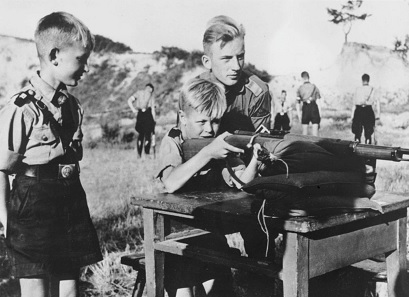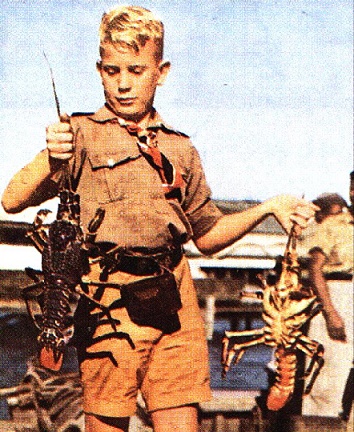
Life in Nazi Germany

Introduction
The ideas, values and attitudes of people in Nazi Germany were very different to today, as is shown in these sources:
After you have studied this webpage, answer the question sheet by clicking on the 'Time to Work' icon at the top of the page
1. Boy Scouts?
from Other Men's Graves (1958), by Peter Neumann. The book claims to be a collection of entries in the diary of a boy recruited from the Hitler Youth into the SS. It is uncertain whether this is a genuine eye-witness diary, or a work of fiction.
 When an instructor blows a whistle, we have to start building dug-outs. There are about a dozen of us, each with a spade.
When an instructor blows a whistle, we have to start building dug-outs. There are about a dozen of us, each with a spade.
And we all start to dig like lunatics. Because in front of us are ten Benz armoured cars waiting, their engines slowly ticking over.
We have twenty minutes to dig the hole which will shelter us. Which will save our lives. It's every man for himself. We aren't comrades any more...
Never mind, I must dig and dig and dig.
I can hear an engine revving up. It is a sinister and menacing sound.
This is it. They're moving off, advancing, straight ahead. The drivers have been ordered to take no notice of anybody clumsy or foolish enough to get in the way. They thunder towards our dug-outs.
With wild shouts the boys jump into the holes they have dug, burrowing into the earth, burying their faces against the damp clay.
In front of me, like some monster in a nightmare, the Benz lumbers forward, its engine roaring. It's getting bigger and bigger, and bigger still...
They're past.
Of course, some of our chaps are killed. But none are cowards.
Thus do we learn courage – at the risk of our lives.
Interrogating the sources:
For each source – looking at all the
details of its
provenance – how true do you think its account is likely to be?
2. Following Orders
from Gestapo (1961), by Edward Crankshaw. Crankshaw was a highly-respected journalist whp worked for the British Secret Service during the Second World War.
SS Major-General Ohlendorf confessed to the murder of 90,000 Jews in Russia. He was asked by his Defence lawyer whether he had ever felt doubts about the tasks he was required to carry out. He answered, "Yes, of course."
"And how was it," the Defence lawyer continued, "that they were carried out despite these doubts?"
Ohlendorf replied: "Because to me it is unthinkable that a subordinate should not carry out orders given by the leaders of the state."
3. Guide Camp?
from Other Men's Graves (1958), by Peter Neumann.
"Tell me, Fraulein Liselotte, if I may call you Liselotte, you seem so charming, and kind. What happens here? I mean, in general. Naturally, I'm not just talking about the genetic part of it, but...
"But you're dying to know how we all go to bed together according to Nazi rules?" she broke in, smiling again. I was rather embarrassed. I must have blushed.
"That isn't quite what I meant. I want to know the routine here."
She became more serious.
"All I can tell you is that we live in dormitories of six or twelve beds. The girls who are ... chosen, are moved to another section, which deals with the legal details of the partnership, and of course any births which result from it. Because we must remember that that's what we're all here for," she ended quietly, looking away.
"A strange thing for your country to ask you to do, don't you agree?"
 4. A true Aryan
4. A true Aryan
from Himmler (1965), by Roger Manvell and Heinrich Fraenkel. Manvell was the first director of the British Film Academy. Fraenkel, born in Poland into a Jewish family, was a Hollywood writer. Together they wrote in the 1960s and 1970s a number of histories about Nazi Germany and its leaders.
Himmler's ideal man was a fair-haired, blue-eyed superhuman athlete whose values came from the knight-farmers of the Middle Ages.
He was a man who despised most developments in modern culture, though he might play accepted music on the violin or read accepted books.
Though he might well be in private a kindly husband and a generous father, he was essentially a destructive man, ready to act on the vilest or most stupid orders.
5. The SS
from John D Clare, The Twentieth Century (1995). Clare was a history teacher and a writer of school textbooks.
After 1932, every member of the SS had to carry his Family Book and ". The SS kept 'stud books' for every SS man whose Aryan blood had to be proved uncontaminated [by Jewish blood] as far back as 1750.
6. 'Protective Custody'
from Twentieth Century History (1979), by Tony Howarth. Howarth's highly-respected textbook was accompanied by a series of videos.
The argument behind [the concentration camps] was brutally simple: certain types of people refused to behave like everyone else – so why not lock them up? The anti-social elements included beggars, gypsies, prostitutes, 'grumblers', alcoholics, hooligans and what the Nazis called 'mental cases'. Homosexuals were definitely 'anti-social', and so were people who refused to work.
By the summer of 1939 there were about 25,000 prisoners in the camps.